7 GTD tricks that will help you work less, get more done and not get tired
20.06.2021“Clear your mind. It’s healthier than emptying the stomach”
~Michel de Montel
Today I will talk about the chips GTD technology, which will allow you to do more, get less tired, increase the efficiency of your own work, reduce stress and increase life satisfaction.
Do you know that your consciousness will constantly remind you of those things and tasks that you thought about doing, but left unattended?
Surely, thousands of unfinished tasks, unprocessed processes that consume your internal resources, strength, energy are already hanging in your brain like a dead weight, and you don’t even know about it. All this creates stress and deprives you of strength. You are worse at new tasks because your head is full of old ones.
I will tell you in this article how to finally clear your head of all this information, improve your work and life.
You’ve probably heard the acronym GTD, which stands for Getting-Things-Done. This philosophy or technology has become very popular due to media coverage as well. A journalist from the Guardian newspaper called David Allen, the author of the GTD philosophy, a man who is called upon to bring order to the universe.
GTD is not just a time-management system for busy top managers with no privacy. This is a system for optimizing and organizing not only labor, but also thinking, consciousness, giving instructions on how to “clear” the mind of unnecessary mental burden, open up space for creativity, new ideas and create psychological prerequisites for comfortable and organized work. This system is designed for a businessman with a million projects, and for a housewife who needs to take care of children, leaving time for reading fiction, and for a schoolboy who is preparing to go to college.
Despite the fact that this phenomenon is well-known, not everyone knows what it is and how it can help you personally. Therefore, today I will literally tell you on the fingers about what it is. After reading this article, you will be able to bring order to your life and thinking today and almost immediately see a positive result from these life innovations.
What prompted me to start organizing my affairs?
Anxiety and guilt don’t come from too much work. It appears automatically when you break agreements with yourself.
~David Allen
Not so long ago I was faced with the need to organize my own work schedule, in which I found a lot of bottlenecks. About 10 years ago, because of my problems with concentration, it was generally extremely difficult for me to do any work for a long time. Over time, I began to work on improving my focus and discipline. I began to learn to relax and keep my promises to myself. This has borne fruit.
I was able to create my own project, promote it, quit my job and start working for myself, just like I dreamed. I was in a sense of progress in terms of working on myself, which was enhanced by the striking contrast between my present and my past. Some time ago, I could not cope with my studies at the institute and simple hired work, and now I worked with discipline for the benefit of my own project and the people who benefit from it, working day after day, on my own, and not “under pressure” .
It was only later that I noticed that this was not the limit. The feeling of success temporarily hid from me the problems that had arisen in the organization of my work.
I have a wide variety of work: letters in the mail, articles on the site, comments, working with students of the course “NO PANIC”, etc. etc. All this requires good organization. I realized about her absence by the fact that the mail had accumulated a lot of unread letters, but marked as “important”. Word files with “plans for 2015”, “tasks for February 2016” were scattered all over the hard drive. The drawers contained notebooks filled with notes, ideas, and, again, tasks I had to complete. Needless to say, I very rarely opened these files and consulted these lists. And this happened not so much because of my indiscipline, but because it all had some kind of uncomfortable appearance, causing an internal feeling of the futility of all these planning activities.
I realized that I still don’t do a lot, although I could do more.
In general, attempts to make an organized list of tasks and, most importantly, to follow it, failed time after time.
Of course, I did urgent daily tasks, but at the same time I felt how many “tasks” and “ideas” were in limbo. All this resulted in the fact that I began to feel less satisfaction from work. There were days when I allowed myself to finish early. I went out, I got on my bike, but instead of enjoying the free time that I wouldn’t have if I worked in the office, I was haunted by the feeling that I didn’t do something, that I didn’t managed. Perfectionist attitudes began to be born in my thoughts: “I should do more”, “I don’t work hard enough”. But I understood that the problem was not in the amount of work, but in its organization.
So I decided to start organizing my entire workspace. I picked up David Allen’s excellent book, How to Get Things in Order. I have heard about the GTD system for a long time, but only now I decided to get to know it better.
What is GTD?
“Unfinished business actually remains unfinished in two places: in reality and in your head. The unfinished business in your head absorbs the energy of your attention, because it haunts your conscience.
~Brahma Kumaris
When I first got this book, I was expecting to read in it some of the banal time management advice I’ve seen elsewhere, like “divide things into important and not important ”, “delegate what can be delegated”.
“Let’s say ten years ago you promised yourself to clean your closet, but to this day, you haven’t done so… we can say that in this case you have been cleaning the closet 24 hours a day for the last 10 years!”
But the author speaks of such a standard approach of “Time Management” as limited and, in many ways, not effective. I liked the fact that David Allen is no longer addressing considerations“effective labor”, but to the possibilities and limitations of human consciousness. To organize our own affairs so that they do not conflict with the peculiarities of our thinking. The GTD approach is entirely based on the conclusions about how our brain works, how it accumulates information, how it processes unsolved problems.
The most basic psychological premise of this philosophy is the fact that any life tasks, whether it is the completion of an important project or a trip to a monastery for a meditation course, our brain perceives as unresolved, keeps in memory, causing mental stress, in the event that we do not formalize these tasks in the form of specific following actions within the framework of an external information storage system.
Don’t be scared and don’t re-read this paragraph! Now I will explain what all this means. A good example is given in the book Getting Things in Order itself. Let’s say ten years ago you promised yourself to clean up the closet, but to this day, you haven’t done it. How has your brain been storing and processing information about this task for all these ten years?
The fact is that psychologists are sure that our consciousness in the context of setting goals has no ideas about the past and the future. These representations exist only conceptually, but they are not in the very algorithms of information processing inside consciousness.
If you make a promise to take yourself to a car dealership next week and try to keep that commitment in mind, your mind will assume that you should do it right now , today, constantly reminding you of this. And tomorrow it will also count the same way.
Your mind can’t just store information about it somewhere in the archive, then to remind you of it seven days later.
The task will be in the “immediate resolution required” status every day, until you go to the service.
Going back to the closet mess example, in this case you’ve been cleaning the closet 24 hours a day for the last 10 years! Your mind regarded this task as unfinished, leaving a place for it in your memory space, creating tension and dissatisfaction due to unfinished work.
And in order to free your memory and free your mind from unfinished processes, reminders of which devour your mental resources (just like background processes on a computer consume processor and memory resources, making the machine slower), you need to perform two key actions.
- Move a task from internal memory (your brain) to external memory (your computer, notebook, tablet, phone)
- Determine what the next specific action will be in relation to the task at hand. For example, the global task “fix the car” can consist of many simple actions. The very first action might be: “find suitable parts on the Internet”.
In this case, your consciousness will free up internal memory and stop constantly reminding you of what you have not done yet. After all, you have shifted all these tasks to an external system.
These are, in principle, the key points of GTD technology, on which everything relies. If you understand this principle, then you already have a general understanding of what GTD is. This is a system of effective case management, creating ideas, which relies both on the external organization of tasks within the framework of records, calendars, a reminder system, and on the internal optimization of the work of consciousness.
Besides, these two levels are interconnected. The external order serves as a prerequisite and tool for an organized and “pure” consciousness. And a clear mind allows you to work more efficiently* and get less tired.
(*Although I use the word “work,” it does not refer exclusively to professional activities. In this context, work is about everything in general. Planning a vacation is also work. Just like thinking about the problem of relationships with your other half ).
Next, I will talk about a few simple features of this system.
Trick 1 – Decide what the next action will be
“When you plan your activity (execution intention) and decide what actions you will perform in what context, you almost automatically set yourself up for the desired behavior instead of mustering all your will into a fist and force yourself to do something.”
~D. Allen
If you read Getting Things Done, you will realize that this is simply the golden rule. The author keeps coming back to it. Moreover, he is obsessed with the idea of teaching the whole world to think about the next action!
Yes, the rule is important, but it takes time and discipline to become a habit.
The fact is that we tend to talk about tasks in a general and abstract way. “We need to make sure that the child learns better”, “I need to become calmer in order to be less involved in conflicts ». Of course, you need to keep the big picture in mind, but in order to bring things to completion, you need to move to the next level of planning, namely, to think about the next action.
In the framework of the examples we have considered, this could be:
- “Find articles on the Internet about developing willpower, discipline, and combating laziness. Or find a book on the subject in a bookstore.
- “Read about relaxation techniques.”
- “Schedule a time to talk to your son about his learning problems.”
The next action doesn’t have to be a physical action. “Think about whether I need to go to college at all” is also an action. You can just think about the task, it is not necessary to start. But by designating just this step, you will already free up part of your brain.
We can’t solve all the problems in our lives. Therefore, it is important to understand that the decision to “do nothing” is also a decision.
This event allows you not only to unload the mind, but also recharge your motivation. Many tasks, when we imagine them in our minds, seem impossible or very difficult. “My God, I’m going to have to take apart my entire summer cottage, it’s work without end!” But it will be much easier for us to get started if we outline a plan in the form of the following actions: “Find the tools you need online”. It’s already easier, isn’t it? And when we do, we will feel the satisfaction of being one step closer to the final goal.
Feature 2 – Transfer to an external system
As you may remember from this article, relying on memory is not only unreliable, but also inefficient in terms of using your brain’s resources. Therefore, David Allen strongly recommends moving all tasks to an external system in order to free up memory.
An external system can be a tablet, phone, notepad, computer, notebook. Any convenient medium that you can work with.
As the author notes, many people, having collected all their affairs and projects for the first time, feel great relief, a feeling of liberation, although sometimes it borders on horror because of the understanding of how much there is to do!
By the way, this is what my to-do list looks like after pre-processing. I removed a lot of unnecessary things from there, things that I had already done or decided not to do at all. That is, at the very first stage and before the application of the “two-minute rule” (about it below), it was much larger.
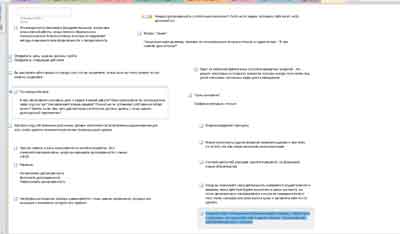
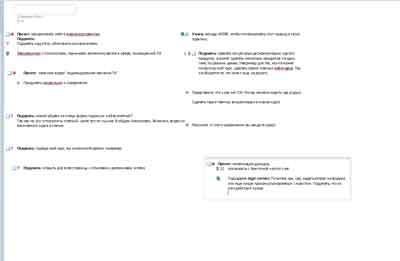
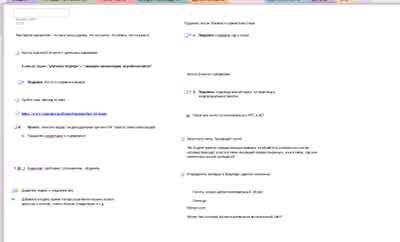
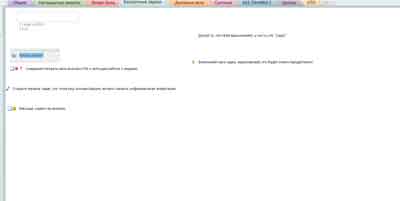
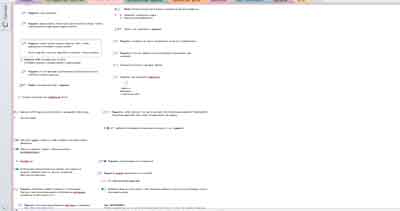
It would not be superfluous to say that the list of tasks should be organized, convenient, accessible from anywhere at any time. It is necessary to keep it constantly up to date and refine it as necessary. Refer to it to check on the progress of your projects.
(That is, not the way I (or maybe you) did: piles of sheets and notebooks in different places of my workspace that I never accessed.)
And of course!!! Each task should be written as the following action!
Amen.
Feature 3 – Organize tasks by context
“It doesn’t take much effort to do something. Much more effort is required to decide what to do.”
~ David Allen
I didn’t see the book giving direct advice on how to prioritize tasks. David Allen is sure that the importance of various tasks for our consciousness is not so critical, since both large and small concerns occupy a place in our consciousness and we need to do them all (or decide not to do it). A trifling task not done, information about which is stored in the mind, can distract you from more “important” matters. However, it does provide a great method of organizing tasks by context or by energy level.
I used to come to this method somewhat intuitively myself, but then I forgot about it because I didn’t formalize it and didn’t make it a habit. For example, there is a large list of tasks. Some tasks require a lot of energy.
For me, these are “Answers to comments and support for students”, “Articles”.
For some, it is not enough, for example, “payment for hosting”, “work with electronic invoices”. I can do this easily when I don’t have time for articles.
Decisions about whether“what should I do now” took away from me, firstly, a lot of energy, and, secondly, had a negative impact on motivation. I could not choose an activity that was optimal for my energy level and because of this I quit work, finishing the working day with the proverbial feeling that I did not do something. Now, if I have little strength and a lot of time, I can just do the work that does not require a lot of energy. I can just look at the list called “low energy” and do something with it. Everything ingenious is simple!
You can also organize the list of tasks by context, for example, “at the computer”, “in the store”, etc. Many other ways of organizing are presented in the book.
Chip 4 – “Two Minute Rule”
A rather simple, but extremely effective rule. If we organize our to-do information into a reminder list, we may be horrified by the size of the list. Fortunately, there is a good and easy way to clean it thoroughly.
You don’t need to write yourself: “reply to a friend’s email when you have free time” if this answer takes you less than 2 minutes!
Just answer right now and clear your head and to-do list of this case. When, after reading D. Allen’s book, I began to sort out my mailbox, I found many unanswered letters there. Of course, once upon a time, I marked them with ticks as important tasks, but then I forgot about them.
In the end, after doing the review, I answered a lot of old emails, and it didn’t take me much time. Some of my readers received a response from me a year later! Please do not be offended by me, this is the result of an overcrowded mailbox and poor organization of affairs. Now I try to answer right away if I understand that the process of reading and processing a letter will take at least 5 minutes. 2 minutes is not strict, let everyone determine the maximum time period for themselves.
In general, the “two-minute rule” is formulated as follows. If, while processing your to-do list, you find a task that will take less than 2 minutes to complete, just do it.
Tip 5 – Write down ideas
You’ve probably noticed that the best ideas about your work come to you when you’re not working! Therefore, D. Allen advises to always have something on hand that will help you save ideas: a notebook, an electronic tablet, etc. The point here is not only that it will help you remember valuable ideas and free your memory from information. Yes, this is also important.
Allen believes that “form determines principles.” According to him, for a person “There may be a subconscious reluctance to think about something due to the fact that you have nowhere to write down the ideas that arise.”
I tested it myself. When I traveled in India, I always carried either a notebook or a phone with me where I could write down my thoughts and ideas. And my mind just gushed with them. I wrote down my thoughts while shaking on the seats of Indian trains, on the tops of picturesque hills, in the ruins of ancient temples, lying under the Sun or under a fan in a hotel room.
I was calm, firstly, from the fact that I had where to fix the ideas that arose, and, secondly, due to the fact that I did not have to keep the ideas in my memory with all my might, I knew that I could always return to them.
Of course, it’s important not only to form the habit of writing down your ideas, but to review this list regularly.
Quotes, valuable rules from other people, by the way, I now also write down, and do not try to keep in memory.
Tip 6 – Do not separate life and work
“Uncollected open questions are equalized in terms of the tension they cause and the attention they demand.”
~David Allen
As I already wrote, for our brain there is not much difference between tasks: “finish a project at work”, “discuss a problem in a relationship with a wife”. Both tasks occupy our memory and consume mental resources, wherever we are, in the office, at home or on vacation.
And the practical conclusion from this principle was a great discovery for me. I used to put off thinking about personal and life problems until later when I got to work. “Because now I’m working! I’m not up to it!” — I thought.
But in fact, the fact that these tasks “hang” in my mind can interfere with my concentration and effective work (here I mean work in the usual sense, as a professional activity). And the worst thing we can do is leave them hanging. Therefore, sometimes it makes sense to solve some urgent family matters, routine tasks, even think about “philosophical questions” that bother you a lot before you sit down to work.
It is clear that there are problems here. You can sink into this thinking for so long that you never get to work. Therefore, it is necessary to approach this principle carefully and consciously. Another good solution would be to put on your to-do list: “think about the meaning of life” and free your head from reminders of this.
Token 7 – Benefit for psychotherapy
“Fruitless and endless scrolling in the head of a thought reduces the ability to analyze and act.”
~David Allen
I could not help but think about the application of this technology to the field of psychology and psychotherapy, the prevention of neuroses, obsessive-compulsive states, destructive attitudes.
There are different methods of getting rid of intrusive, negative thoughts. Some psychologists recommend subjecting such thoughts to careful logical analysis. Others use calming and realistic affirmations.
Although I use these approaches in my practice of helping people with panic attacks, I understand that the possibilities of our logic in a state of anxiety and panic are very limited, and there is always a chance that such an analysis will be turned against whoever applies. So I basically recommend just patiently not reacting to intrusive thoughts.
But I also think that the principle of “mark next action” and “concentrate on the goal” can be used very well in relation to obsessive thoughts and negative attitudes.
Let’s say you suffer from hypochondria.
You think: “I have a terrible and fatal illness.”
Okay, now think: “What’s the next action?”
“Maybe I should go check it out. But I’ve already been to the doctors this week, the tests did not show anything terrible!
Everything fell into place, didn’t it?
Or you have social phobia:
“People don’t accept me, I’m a worthless person”
What is the next action?
“I will work to improve my social qualities and I will start with….” or/and “I will learn to accept myself as I am and I will start with…”. Most often, both the first one and the second skill are required in combination to solve problems of self-doubt, social phobia, etc. The formulation of the next action will not only set you up for the goal, but also show that achieving the goal is possible!
And even if it’s not possible, the next action would be: “I won’t do anything about this problem. Because it can’t be fixed. If so, why think about it?”
This approach will help you think not about the problem, but about its solution! Anxious, suspicious, restless people are often very fixated on problems. “I have few friends”, “fear does not leave me”, “everyone thinks badly of me”, etc. They ask more “why” questions than “what to do about it”, which only creates new anxiety and a sense of helplessness.
But the question: “what’s the next action?” immediately sets you on the path to solving the problem (or deciding to do nothing), which can free your head from a whole bunch of negative, meaningless thoughts about the problem. In general, try it!
What can be achieved with GTD?
“The problem isn’t lack of creativity, but removing barriers to the natural flow of creative energy.”
~ David Allen
The application of the GTD methodology goes far beyond improving labor efficiency. Therefore, by implementing at least some aspects of this approach in practice, you will feel not only an increase in productivity, but also a greater clarity of consciousness. The purpose of this system is not only to make you work better, but to free your head from unnecessary thoughts about work, unfinished tasks. So that you can easily let go of thoughts about what you cannot change or have a solution ready for what needs your action.
A person who puts things in order in his affairs will have order in his head, it will be easier for him to concentrate, generate ideas and relax.
One has only to stop convulsively remembering our obligations, keeping in mind a lot of unfulfilled tasks and thoughtless problems, as our consciousness clears up, and we will have more energy, more strength, more room for creativity and new ideas. Perhaps it will even help meditation? There will be fewer worries and problems in the head, therefore, concentration and calmness in meditation will be deeper. It is not for nothing that D. Allen uses the phrase “mind is like water” throughout the book.
GTD, according to its author, is a global technology for self-improvement, and not just a way of time management.
Personally, I’ve only recently started using it. And I can say that I have a greater sense of control over affairs, a greater sense of satisfaction about the work. I began to feel great joy from the completed tasks and came out of the feeling of “a constant, never-ending project.” And most importantly, a lot of space has opened up for me to improve my affairs and my work.
May the power of recording the next action within an external reminder system be with you!








